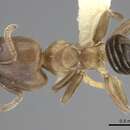en
names in breadcrumbs


Figures 2,4A,5.
Azteca brevis Forel , 1899:121. Syntype workers: Costa Rica ( Tonduz ) [ MCZC ] (examined).
Azteca JTL-001: morphospecies code used in Longino 1996:141.
Queen characters. Measurements (n=9): HLA 1.57 (1.49-1.59), HW 1.11 (1.10-1.16), SL 0.62 (0.60-0.64), CI 74 (72-76), SI 41 (40-42).
Palpal formula 5,3; middle and hind tibia with prominent pectinate apical spur; dorsal surface of mandible coarsely punctate, puncta bearing stiff erect setae, mandible appearing bristly; medial and lateral clypeal lobes at about same level; head subrectangular, posterior margin weakly excised medially; petiolar node short, broadly triangular; posteroventral petiolar lobe strongly convex from front to back, laterally compressed and tectiform; scape with sparse and inconspicuous erect setae, about as long as one third maximum width of scape; hind tibia devoid of erect setae or with at most 1 or 2, side of head with 0-2 short setae near mandibular insertion, setae lacking elsewhere, posterior margin of head with moderately abundant erect setae; pronotum with posterior row of erect setae and occasionally setae on medial area; mesoscutum, scutellum and propodeum with moderately abundant erect setae; petiolar node lacking rim of whitish erect pubescence, in profile with 2 erect setae projecting above apex, posteroventral lobe with abundant long setae; gastral terga with sparse erect setae; general body color dark brown.
Worker characters. Measurements (n=3): HLA 1.07 (0.99-1.09), HW 0.96 (0.89-1.00), SL 0.51 (0.48- 0.51), CI 93 (92-94), SI 49 (48-50).
Palpal formula 5,3; middle and hind tibia with prominent pectinate apical spur; dorsal surface of mandible with abundant piligerous puncta, surface between puncta smooth and shining, variable extent of base faintly microareolate; medial and lateral clypeal lobes at about same level; head subquadrate with weakly convex sides, moderately excavate posterior margin; in lateral profile mesosoma compact, pronotum and mesonotum nearly forming a single convexity, with promesonotal suture very weakly impressed; scape with sparse, inconspicuous erect setae, length of setae about one half maximum width of scape; hind tibia lacking erect setae; side of head lacking erect setae; posterior margin of head with sparse erect setae; pronotum and mesonotum with abundant erect setae, dorsal face of propodeum lacking erect setae; color red brown.
Similar species. The bristly mandibles ally this species with A. forelii and A. nigricans . Queens of A. brevis are smaller than queens of A. forelii (Fig. 4A). Queens of A. brevis have shorter scapes than queens of A. nigricans (SI 39-43 versus 50-52, respectively). Workers of A. brevis are distinguished from workers of A. nigricans by the reduced number of setae on the hind tibia, 0-2 on A. brevis versus> 5 on A. nigricans .
Range. Costa Rica.
Biology. In Costa Rica A. brevis is known only from the Pacific side, and mostly from the wet forests of the southern Pacific lowlands. Nests are in live stems of trees. Stems occupied by ants are covered with runways of characteristic crusty black carton, with the carton full of small round holes from which workers emerge. Colonies are polydomous, with workers and brood distributed in multiple branch tips. Colonies maintain large populations of coccoid Hemiptera inside the stems. Nests have been found in Licania (Chrysobalanaceae), Grias (Lecythidaceae), Myriocarpa (Urticaceae), Tetrathylacium costaricensis (Flacourtiaceae), Ocotea nicaraguensis (Lauraceae), and an unidentified tree in the Moraceae. Leanne Tennant, studying the incipient ant plant Tetrathylacium costaricensis , found A. brevis to be one of the most common inhabitants.
Comments. This species was discussed in Longino (1996) as an unnamed morphospecies (JTL-001) similar to A. nigricans . Examination of the types of A. brevis revealed that it was conspecific with this morphospecies.
Additional material examined. COSTA RICA : Guanacaste : Cerro El Hacha, Guanacaste Conservation Area , 10°59'N , 85°33'W , 300m , 1 Jan 1988 - alate queen [ MUCR ] ; Puntarenas : Sirena, Corcovado National Park , 8°29'N , 83°36'W , 5m , Feb-Apr 2000 ( M. Schmidt ) - alate queen, worker ; same locality, numerous collections and dates ( J. Longino ) - worker, queens, males ; same locality, numerous collections and dates ( L. Tennant ) - workers, queens ; 19km SCiudad Neily , 8°29'N , 82°58'W , 20m , 25 Mar 1990 ( J. Longino ) - males, alate queens ; Golfito , 8°39'N , 83°09'W , 50m , 6 Aug 1957 ( A. Menke ) - alate queen [ LACM ] .